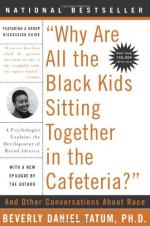
|
| Name: _________________________ | Period: ___________________ |
This test consists of 15 multiple choice questions and 5 short answer questions.
Multiple Choice Questions
1. What term refers to the indigenous peoples in North America within the boundaries of the present-day continental United States, parts of Alaska, and the island state of Hawaii?
(a) Latino.
(b) Caucasian.
(c) Asian-Pacific American.
(d) Native Americans.
2. What was a landmark decision of the US Supreme Court that declared state laws establishing separate public schools for black and white students unconstitutional?
(a) Pace v. Alabama.
(b) Loving v. Virginia.
(c) Johnson v. Alaska.
(d) Brown v. Board of Education.
3. Barack Obama's father is from ___________.
(a) Ecuador.
(b) Japan.
(c) Egypt.
(d) Kenya.
4. What is a term sometimes used in the United States to include both Asian Americans and Pacific Islander Americans?
(a) Asian-Pacific American.
(b) Native Americans.
(c) Latino.
(d) Caucasian.
5. When did the Virginia General Assembly pass "The Racial Integrity Act" and "The Sterilization Act"?
(a) 1911.
(b) 1953.
(c) 1879.
(d) 1924.
6. In Part III, Understanding Whiteness in a White Context, Chapter 6, The Development of White Identity, Tatum recommends that whites find most positive redefinition by what means?
(a) Allying with other white resistors of racism.
(b) Ignoring the values of race.
(c) Allying with Asian resistors of racism.
(d) Allying with black resistors of racism.
7. Multiracial US Americans officially numbered how many in 2006?
(a) 12.8 million.
(b) 2.4 million.
(c) 6.1 million.
(d) 19.5 million.
8. What is the first of three stages of racial consciousness in minority groups delineated in Jean Phinney's model of ethnic identity development?
(a) Achievement.
(b) Abandonment.
(c) Searching.
(d) Unexamined.
9. What means conforming to the standard or the common type; usual?
(a) Amoral.
(b) Eccentric.
(c) Normal.
(d) Individualistic.
10. What governmental agency is represented by the initials OMB?
(a) Office of Maritme Boating regulations.
(b) Office of Merchants and Bankers.
(c) Office of Military and Building.
(d) Office of Management and Budget.
11. What refers to state and local laws in the United States enacted between 1876 and 1965 that mandated racial segregation in all public facilities?
(a) Colored laws.
(b) Segregation laws.
(c) Jim Crow laws.
(d) White suprmecist laws.
12. What refers to a person's identity and sense of belonging to one state or to one nation, a feeling one shares with a group of people, regardless of one's citizenship status?
(a) Nativism.
(b) National identity.
(c) Autonomy.
(d) Reverse discrimination.
13. Barack Obama was born in what year?
(a) 1969.
(b) 1973.
(c) 1961.
(d) 1944.
14. In what year did Virginia law state that to be defined as "mulatto," a person had to have at least one-quarter African ancestry?
(a) 1907.
(b) 1822.
(c) 1872.
(d) 1946.
15. What is the third of three stages of racial consciousness in minority groups delineated in Jean Phinney's model of ethnic identity development?
(a) Unexamined.
(b) Abandonment.
(c) Achievement.
(d) Searching.
Short Answer Questions
1. What is the belief, and promotion of the belief, that white people are superior to people of other racial backgrounds?
2. Tatum writes in Part III, Understanding Whiteness in a White Context, Chapter 6, The Development of White Identity that many Whites' only sense of Whiteness is that it is "normal," but true, positive white identity should be based in what?
3. What refers to doubtfulness or uncertainty of meaning or intention?
4. Executive Order 10925 was signed into effect on what date?
5. To avoid accusations about reverse discrimination for goal-oriented affirmative action it is imperative to establish in advance clear and meaningful what, according to the author?
|
This section contains 505 words (approx. 2 pages at 300 words per page) |

|




